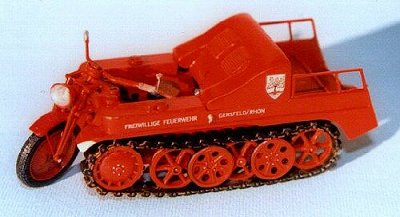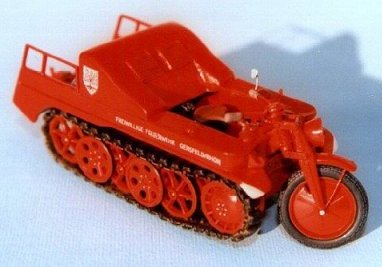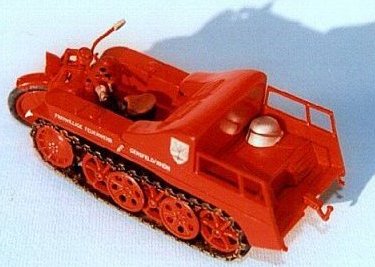 |
|
 |
 |
 |
|
 |
 |
| SOGGETTO
Il vero problema non sono le armi, ma l'uso che se ne fa. Per questo mi piace evidenziare come "civile" e "militare" siano solo due termini usati per connotare - spesso in modo improprio - aspetti diversi della medesima realtà. Il Kettenkrad (abbreviazione di "kleines Kettenkraftrad", "motoveicolo cingolato leggero") è uno strano veicolo, recentemente portato alla conoscenza di un vasto pubblico grazie al combattimento finale del film "Salvate il soldato Ryan". Esso consiste di un telaio cingolato, azionato da un motore a benzina Opel in posizione centrale, con un sistema di direzione che combina la ruota anteriore, collegata ad un manubrio di stile motociclistico, con l'azione assimmetrica dei freni posti su entrambi i cingoli. Ho riprodotto un esemplare sopravvissuto alla guerra ed usato come trattore leggero dai vigli del fuoco volontari di Gersfeld/Rhön, in Germania, come appare nel libro di Udo Paulitz "Feuerwehr Oldtimer". Anche l'elmo protettivo, pur facendo parte dell'equipaggiamento standard dei pompieri tedeschi, ha esattamente la stessa forma di un comune elmo della Wermacht, a parte la cromatura che serve a difendere dal calore del fuoco durante le operazioni di salvataggio. |
SUBJECT
Weapons are not the problem: it is the way you use them. That's why I am use to higlight how civil and military are just two labels used to brand (sometimes not appropriately) different aspects of the same real world. The Kettenkrad, short for "kleines Kettenkraftrad", (small tracked motorvehicle) is an odd vehicle, recently brought to fame among a wide audience by the final fighting of the movie "Saving private Ryan". It consists of a tracked chassis, powered by an Opel petrol engine in central position, with a driving system that combined a motorbike-like handlebars-controlled steering wheel and the asymmetric action of brakes on both tracks. I depicted an example that survived to the war to be used as a ligt tractor by the volounteers firemen in Gersfeld/Rhön (Germany), as shown in Udo Paulitz's "Feuerwehr Oldtimer" book. The protective helm as well, though being at present a standard equipment by the German firemen, is fashioned exactly like a common Wermacht equipment, just chromium-plated to reflect fire heat during rescue operations. |
| MODELLO
Tamiya fornisce una buona base di partenza per questa semplice conversione nella classica scala 1/35. Con plasticard e stucco ho risagomato lo speciale cofano motore. quindi ho rimosso i due sedili posteriori, stuccando i fori rimasti nel piano di carico così ottenuto, ed i corrimano laterali sono risagomati con strisce di plastica, mentre ho dettagliato il manubrio e la ruota anteriore con un nuovo fanale ed un parafango più fine. Un nuovo specchietto, i fari posteriori ed il tappo del serbatoio completo di catenella completano la costruzione. Per lo stemma comunale e le iscrizioni sui lati ho acquisito allo scanner il disegno nella foto del libro citato, completandolo mediante Corel Draw, ed ho poi stampato il tutto, con una stampante a colori Alps MD-1000, su un foglio di decal trasparente. |
MODEL
Tamiya offers a good starting base for this simple conversion in 1/35 classic AFV scale. I reshaped the special engine cowling with plasticard and filler, then I removed the two back seats, filling gaps in the loading deck, and the side railings are reshaped with plastic strips, while the steering wheel is detailed with a new light and a thinner mudguard. A new rear-view mirror, backlights and a chain-fitted fuel tank stopper completed the construction. A scan from the book's picture and some artwork with Corel Draw made for the town's emblem and the writings, printed with an Alps MD-1000 printer on clear decal sheet. |